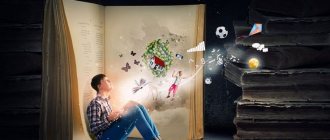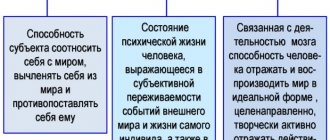Imagination is the ability of the psyche to create images in consciousness. All processes that occur in images are called imagination. Imagination as a mental process constitutes visual-figurative thinking, thanks to which a person can navigate and search for solutions to problems without the direct intervention of practical actions. This process is very important, especially in cases where it is impossible or difficult to carry out the required practical action, or it is simply impractical.
This process reflects the human world around us at higher mental levels. The most popular definition of imagination is a mental process, the essence of which is the creation of new unique images through the processing of the perceived material of ideas that came with previous experience. It is also considered as a phenomenon, as an ability and as a specific activity of the subject. This process has a complex functional structure, so Vygotsky defined it as a psychological system.
The function of imagination is unique to humans and has a certain significance in a person’s specific professional activity. Before embarking on a certain activity, he imagines what the object will look like and mentally creates an algorithm of actions. Thus, a person constructs in advance an image of a future object or the final result of an activity. Developed creative imagination plays a great role in creative professions. Thanks to their developed creative abilities, people earn a lot of money.
There are several types of imagination: active (voluntary), passive (involuntary), recreative, creative.
What is imagination
By definition, imagination in psychology is a process in which images appear in the subconscious that are closely related to life experience, fantasy and way of thinking. It helps to imagine the consequences of certain actions, as well as outline a plan of action in an unclear situation.
According to scientists, imagination is one of the types of brain activity in which new additional neural connections are formed. We can also say that this is a process of transforming reality, creating images associated with it, processing the resulting practical, intellectual and sensory experience. These images are bright, original and at the same time truthful.
Imagination can be called a way of understanding the world around us. It leaves an imprint on our consciousness. Thanks to this, you can not only replay what happened recently, but also imagine what will happen in the future. You have the opportunity to imagine non-existent or absent objects and mentally use them in your consciousness.
It is interesting that even the most pragmatic, skeptical people have imagination. They may live by logic, ironclad principles and rules, but will still dream or think creatively.
The role of imagination in human life
A good imagination is a necessary quality for success.
Unlike animals, man, with his ability to imagine, acts in the future, planning the future.
Imagination stimulates a person to action, forces him to go through a complex, multi-stage path, and encourages him to believe in the result of his work.
But, from another point of view, a dreamer satisfies his needs mentally, refusing real efforts.
Such a negative factor reduces a person’s activity, turning imagination against reality.
Fantasy plays a big role in the production of new inventions. Any modern, familiar object was a figment of human imagination hundreds of years ago.
Through imagination and hard work, new advances are constantly introduced into people's lives. A developed imagination is an essential ability of a successful person.
Functions of the imagination
The importance of imagination is difficult to overestimate. Like any other mental process, it has a number of functions:
- Cognitive. This is a function of both thinking and imagination. Helps broaden your horizons, obtain new information and knowledge, and draw up a plan of action in an unfamiliar situation. Teaches a person to be guided by guesses, reasoning and considerations.
- Prediction function. A person can imagine what will follow his actions. This type of imagination is involved in the formation of dreams and daydreams.
- Understanding. It manifests itself in the ability to assume what another person feels and experiences in a given situation, what emotions and sensations he or she has now. This type of imagination is somewhat similar to empathy. It allows you to look into the inner world of your interlocutor and understand what worries him at the moment.
- Protection. When a person plays out a situation in his mind, a possible outcome of events or the consequences of his actions, he can prevent troubles and protect himself from problems.
- Self-development. This function of imagination helps to fantasize, come up with something new, and create.
- Memories. Images from the past emerge in the subconscious.
Not every person has all the functions of the imagination. Their set depends on character, behavior, personal qualities.
Development of imagination
As has already been shown, imagination is an important component of mental activity. Its development promotes personal growth. Therefore, it is not surprising that many want to improve its performance. The famous director Konstantin Stanislavsky, when developing his acting system, paid attention to ways to develop imagination.
- Expanding your horizons and knowledge base . As follows from the definition of imagination, for its greater diversity it is necessary to replenish your library of images and knowledge so that you can create more original and complex images of the imagination.
- Ability to present a subject clearly . The more clearly we imagine an object, the more detailed we can use its characteristics.
- Purposeful Imagination . By being able to control the flow of images created by the imagination, we thereby subjugate it to ourselves. This way, in a problematic situation, we can use our imagination faster and easier.
- Constant use of imagination . Don't be lazy and automatically do things where you can use your creativity. The more often we use some mental function, the more attention we pay to it, the more developed and flexible it becomes.
By developing our imagination, it doesn’t just become easier for us to solve creative problems. Our imagination, closely interconnected with all mental processes, is an important component that helps to find a way out of any difficult situation.
We constantly detect plagiarism on our materials without providing a clickable follow link to them.
In this case, without warning, we turn to Google DMCA , which leads to pessimization of the plagiarist. On the contrary, we welcome the popularization of our materials, but with the obligatory active follow link to this page psyhosoma.com/voobrazhenie-i-ego-rol-v-zhizni-cheloveka/ .
Types of imagination
The most basic types of human imagination are passive and active. Each of them is divided into subgroups. Among them are voluntary, involuntary, creative, reproductive imagination, etc. Let's take a closer look.
Passive
Such imagination may have a purpose. It can be regulated and directed using consciousness and willpower. It can also be involuntary, that is, working at the subconscious level.
Operations of imagination have varying degrees of awareness and unconsciousness. You've probably also encountered a state where thoughts fly through your head one after another. Along with them, some images and pictures appear. They replace each other until something interests you. At this moment, awareness turns on. You begin to control the process. In addition, you become aware of the line between reality and the fictional world.
In the case of the involuntary variety of imagination, everything happens spontaneously, uncontrollably. You don't have images and associations.
In psychology, dreams and hallucinations are classified as passive involuntary types of imagination:
- Dreams are the result of a healthy psyche. This is a combination of inhibition and excitation processes occurring in the cerebral cortex. During braking, the subconscious comes into play, which stores a huge amount of various information. For example, remember the children's toy kaleidoscope. So, images and associations from the subconscious are mixed and intertwined, as a result of which colorful and sometimes unusual dreams appear.
- Hallucinations occur when the functioning of the cerebral cortex is disrupted. They often occur in cases of serious illness, excessive consumption of alcoholic beverages or drugs, or mental disorders. It also happens that they are a consequence of emotional overexcitation, a state when a person is unable to control himself.
The main property of both types is the inability to control them.
Passive voluntary types of imagination can be controlled. Most of them are related to forecasts for the future. A person predicts the probable, unlikely and completely incredible outcome of events. In this case, you don’t have to limit your imagination.
Passive voluntary imagination has 2 forms:
- Daydreaming is not just a way to fantasize. This is an opportunity to recreate images of the future. And, what’s most interesting, they are quite feasible. The main property of such imagination in psychology is to encourage a person to take active action, to coordinate his actions in the direction of his dreams.
- Dreams have nothing to do with reality. This is an illusion, a figment of the imagination, something that cannot be realized.
Sometimes it is difficult to see the line between dreams and daydreams. For clarity, let's give an example. Imagine a girl reading an exciting novel. According to the plot, three young men fall in love with the main character. If a girl also wants to be in such a situation, this is a dream. And if she wants to write and publish an equally exciting story, this is a dream come true.
Active
Active voluntary imagination is the most significant thing in a person’s life. It is used in almost all areas of life. Helps to recreate images from the subconscious in reality.
According to the classification of types of imagination, active is divided into 2 subtypes: reproductive and creative.
Imagination and creativity are closely related. Creative imagination is considered the highest form of all cognitive processes. It helps in creating both fantastic and very real images. Take, for example, painting realistic landscapes or literary works. This type of imagination plays a special role in science, the work of designers, etc. One might even say that it is involved in almost all areas of life.
The creative imagination has another interesting feature. It helps you see a situation from different angles, generate unusual ideas and make innovative decisions.
In psychology, this type of imagination is associated with inspiration, the subconscious, and intuition. A lot of creative imagination techniques have also been developed, the use of which helps to increase productivity and make your activities more interesting and exciting.
Reproductive imagination is also called re-creative. It is used when you need to recreate images based on a ready-made description, diagram or drawing. What can you imagine? There are a number of examples:
- house according to the drawn up project;
- drawing connected according to a pattern;
- the hero whose description is given in the book;
- cake or other dish that will be prepared according to the recipe.
Recreative imagination has an interesting characteristic. All images are based on what a person already knows. Take, for example, the house project described above. Only a person who has special knowledge and skills can understand it.
Role in activity
Recreating imagination plays a huge role in those types of human activities that do not involve the possibility of using practical experience .
Thus, historians describe events, eras and people from the past, relying on the impressions that arise in their minds.
These impressions are formed based on the information received.
Psychologists, sociologists, political scientists, philosophers, geographers, zoologists and many other specialists often do not have the opportunity to directly touch, hear, or study the objects they study.
Without reconstructive imagination, such types of activities would be reduced to mechanical memorization of known facts, and everything else would remain outside the scope of knowledge.
It should be borne in mind that the recreating imagination itself does not allow for effective implementation of activities if it is not based on real information.
That is, the ideas being recreated must correspond to reality and be correct.
The more extensively, accurately and accurately an individual’s ability to formulate intelligent conjectures is developed, the more reliable beliefs will ultimately be formed.
Creating images
A person creates images in the imagination in several ways:
- Agglutination. The qualities and parts of individual objects are combined into a single whole. Examples: centaur, fairy-tale hut on chicken legs, seaplane, snowmobile.
- Emphasis. Part of the object is divided into separate parts. A good example is caricatures in which the artist highlights a certain feature.
- Hyperbolization. Involves reducing, enlarging, or shifting individual parts of the selected object. Here you can also remember fairy tales, for example, about dragons with several heads.
Another way to create images in the imagination is typification. It is considered the most difficult. Imagine any picture. Contemplating it, you draw in your subconscious the image that the artist conveyed. Or take, for example, a book. The author describes in it the features of the main character. Thanks to this, you can imagine how he looks, thinks, behaves. It is as if you are transported into the world around him.
Mechanisms for creating images
Without imagination there would be no books and films
The images that arise in the imagination do not appear out of nowhere. They proceed from received ideas about real phenomena and objects.
Life impressions are combined in a person’s imagination, taking on various forms.
Imagination processes are divided into two levels:
- Analysis of impressions.
- Synthesis of the resulting images.
At the first level, ideas about an object are abstracted from other images, their components are separated, and analysis occurs. Subsequently, these images are transformed: combined into different combinations or reincarnated into completely new ideas.
This synthesizing process takes many forms. Agglutination is one of the common forms of synthesis, during which a new image is created by transferring the characteristics of one object to another.
In this way, images of ancient gods and mythical creatures were created in the imagination. The technique of agglutination is widely used in art and other creative processes.
For example, in order to draw a non-existent animal, it combined the features of various famous animals and birds. With the help of agglutination, parts of an object or the entire object are increased or decreased. This is how fairytale giants and gnomes were created.
By introducing existing ideas into new situations, new connections with completely different meanings are obtained. A person achieves correspondences in this combination by imagining the goal and controlling the process.
The synthesis of ideas is carried out through schematization and emphasis. Schematicization occurs as a result of insufficiently complete perception of the object. As a result, the holistic image may be distorted and inconsistent with reality.
Also, schematization can manifest itself when forgetting some properties of an object and representing it in a more generalized way. A person can consciously or unconsciously highlight certain features in an image.
Emphasis lies in focusing attention on the main properties of the image and creating a typical idea of the subject. In this complex creative process of generalization, a person identifies the main, in his opinion, features in the image and reflects reality through his own prism.
What does imagination give to a person?
So, we found out what imagination is and what functions it plays. But why do you need it personally? There are several points:
- helps in communicating with other people;
- makes it possible to visualize the goal;
- promotes the development of creative talents;
- participates in decision making and creation of new ideas;
- helps you mentally recreate an image of an object or phenomenon that you have never seen.
Plus, imagination is used in making predictions and action plans for the future. It is needed in all areas of activity, especially in those that cannot be fully automated. We are talking about design, research work.
Does a child need imagination? The answer is clear: yes. Without it, full development is impossible. The first few years of a child's life explore the world around him. And if for some reason his imagination does not work at full strength, the formation of important abilities is inhibited.
The imagination developed in childhood will help an adult to become creative in the future, develop creative skills, and learn to find an unusual way out of a difficult situation. And this will be useful in life.
Imagination and creativity
Creativity is the process of creating fundamentally new or improved methods for solving tasks and problems. It becomes obvious that imagination and the creative process are very interconnected.
Imagination here is defined as the transformation of ideas about reality and the creation of new images on this basis. It works every time a person thinks about some object or phenomenon, without even coming into direct contact with it. Thanks to creative imagination, the transformation of this idea is carried out.
Creative thinking and imagination have their own specific characteristics. Through this process, it is possible to create completely new, unique representations based on the subject's own ideas and thoughts, which express the personality of the creator. It can be voluntary or involuntary. To a large extent, creative imagination or inclination towards it is determined from birth, but it can also be developed.
The development of creative imagination occurs in three stages. At first, a creative idea arises. In the mind of the creator, a fuzzy image first appears, an initial idea that can be created arbitrarily, without purposeful comprehension of the idea. The second stage involves hatching a plan. A person thinks about strategies for translating an idea into reality and mentally improves it. The third stage completes the incubation of the idea and brings it to life.
The development of creative imagination is carried out in the process of transition from involuntary to voluntary, from recreating to creative. During childhood and adolescence, creative imagination has characteristic features; it is special for its magic, fantastic judgments about the world and the absence of a critical component of thinking and rationality. During adolescence, complex changes occur in the body, and therefore in consciousness as well. Objectivity is developed, perception becomes more critical. Rationality of perception appears a little later, when a person becomes an adult. The adult mind begins to control the imagination, often too much criticality and practicality weakens the processes of fantasy, overfilling them with meaning, loading them with some kind of information that is actually unnecessary.
There are certain methods for developing creative thinking. The most practical method is to read literature and watch scientific films, expand the range of your knowledge, draw knowledge from different areas of life, memorize and analyze information. In this case, a large amount of materials for creative processes appears.
Imagine imaginary objects, try to carry out various manipulations with them. For example, imagine the sea, hear the sound of breaking waves, feel the breath of sea freshness, imagine entering the water, feel its temperature, and so on. Or another example, imagine a pear. Imagine its shape, size, color. Use tactile perception, imagine it when it is in your hand, feel its surface, aroma. You can mentally take a bite of it and imagine the taste.
In order for the imagination to be voluntary, it is necessary to work on it through regular training. To make the effect even greater, you need to look for sources of inspiration, ask friends for help, and ask about their ideas. Try group work to create ideas, sometimes the results are very unique, and a person becomes more active if the process of imagination occurs in a circle of other creative individuals.
How to develop your imagination
Psychologists have identified a number of techniques for developing imagination.
In adults
The main thing is to be ready to experiment, not to be shy and not afraid of mistakes. There are many ways:
- Visualization. You need to mentally reproduce the appearance of an object, location or action. Start with simple tasks. For example, look at what lies in front of you. Then close your eyes and imagine this object in detail.
- Reading. This method is related to the previous one. Visualization is also needed here. It's just much more difficult to make it. You will have to remember several characters, images, landscapes at once. And after that, look at their participation in the plot. All this will help you see the full picture. And by the way, reading is much more interesting than watching movies. In the case of reading, no one limits your imagination and imagination.
- Associations. Every adult has associative thinking. Most likely, when you hear the word “green,” you think of grass and trees. And with the word “orange” - about an orange.
- Creation of unusual animals. This is a great way to develop your creative imagination. Let it be, for example, a cat dog. Of course, they don’t talk about it in a biology textbook. But you'll have fun. This exercise is suitable for both adults and children.
- Art. Exhibitions or master classes will make up for the lack of imagination. By observing other people, you yourself can easily create an unusual idea or at least get inspired.
- "Box". Here you will have to take an example from the cartoon character SpongeBob. Remember your favorite activity? He sat in the box and turned on his imagination. No, don't think that you need to do the same. Although children can try. Walk into an empty room and mentally design the interior. Next time, rearrange it, etc. This way you will improve your imagination and perception.
Another way is role-playing games. You control the hero, while observing certain requirements and conditions. Games can be tabletop or real. The latter include quests.
In children
It's a little easier with children. They already love to fantasize, often coming up with unusual stories and even imagining imaginary friends next to them.
How to develop children's imagination?
- Read fairy tales, fantasy stories. Try to read, for example, to the middle. And then invite the child to continue the story.
- Observe the people around you. Let the child think about how someone lives along the way. If you can’t go outside, use photographs or ordinary pictures. This way you can help develop the imagination of both preschoolers and older children.
- Go to exhibitions together, visit museums, cinemas.
- Get creative together. Model from clay and plasticine, make appliqués, draw, assemble car models, etc.
As with adults, role-playing games with parents or peers help children develop their imagination.
Properties and meaning
Main properties of this ability:
- reproductive nature;
- integrity;
- dynamism, flexibility, versatility of the process;
- dependence of the accuracy of reconstruction on personality characteristics (level of knowledge, talent, life experience, upbringing, age).
Recreating imagination is of great importance because it helps to mentally imagine and predict the surrounding reality.
In activity, this is expressed in the ability to regulate cognitive processes, control events, formulate a plan of action, and determine the desired result.
Any anticipation of the expected result (guesses, intuition, premonitions, insights) is based on the reconstruction of existing ideas.
All significant achievements of mankind in the field of science, technology, literature, and fine arts occurred as a result of the work of individual people's recreating imagination , based on existing ideas and knowledge about the surrounding reality.
With the help of this process, a person can regulate not only his activities, but also change his emotional state.
For example, during stressful situations, you can bring to mind the images of loved ones or images of positive events from the past. This helps to lift your spirits and increase your belief in success.
Example from life
I enjoy reading. Imagination helps you immerse yourself in the story. Even seemingly tedious descriptions of the area become much more interesting. I try to see the landscape through the eyes of the author, hear sounds, feel the wind or the scent of flowers.
The same goes for heroes. I try to imagine not only their appearance, but to monitor how their behavior and thinking changes in different situations. Thanks to this, after reading the book, it seems that I have visited this book world.
Examples
The reconstructive imagination works most clearly in the process of cognitive activity .
Thus, during training, schoolchildren constantly imagine various images based on the information given to them by the teacher.
During a geography lesson, images of rivers, lakes, mountains and plains appear in the mind.
Natural phenomena in the form of a volcanic eruption, waterfall, earthquake have never been observed by most children in real life , but this does not prevent them from imagining them.
When hearing about historical events, children imagine battlefields, faces of government officials, buildings of past times, etc.
The more accurately, vividly and interestingly the teacher presents the material, the more reliable images are formed in the minds of students.
This helps to effectively perceive information and consolidate knowledge. Rote learning, which does not resonate with the imagination, does not allow the brain to work to its full potential.
fiction is no less significant .
A writer, when creating a work, is guided by his own fantasies and ideas.
Subsequently, readers who become acquainted with his creation project personal images in their minds . Moreover, the presence of specific descriptions and characteristics of characters, settings, and events never leads to the formation of uniform images among readers.
Each person, getting acquainted with a literary work, perceives it through the prism of his own ideas. It is for this reason that film adaptations of popular books cause a lot of controversy among their fans.
Every reader wants to see on the screen exactly the picture that his imagination drew while reading. This applies to the appearance of actors, interiors, nature, events, etc.
During the creation of the film adaptation, the director adheres to the images that the work evoked in his own mind .
Recreative imagination manifests itself systematically in everyday life. While waiting to meet a stranger, we involuntarily draw his image in our minds.
The basis can be information received from mutual friends, images in photographs, a voice heard on the phone, etc. When a real person turns out to be completely different from how we imagined him in our minds, we are convinced of the inaccuracy of the supposed image.
The concept of imagination
Psychological essence of imagination. As a subject of action, a person not only contemplates and cognizes, but also changes the world, transforms nature, creates objects that do not exist in it. But a person would not be able to do all this if he did not clearly imagine the result of his actions. To transform the world in practice, you must be able to transform it mentally, in imagination.
Imagination is a mental process as a result of which a person creates an image in his mind that does not yet exist in reality. The basis for creating such an image is the past experience that a person receives by interacting with objective reality. Thus, imagination is the process of transforming ideas that reflect reality, and creating new ideas on this basis. Like any mental process, imagination reflects
:
ñ something that exists, but is inaccessible for some reason;
- something that happened, but which a person could not witness;
ñ something that does not exist, but that can be;
- what will never come true will not happen.
Thus, in the imagination, a person goes beyond the real world in time and space; can connect and separate the indecomposable and incompatible; can move things, events, processes from the present to the future, to the past, from one space to another.
Imagination arose in the process of labor - a specifically human activity, due to the existence of the need to transform objects of the real world. For example, having before his eyes a tool of labor that was not entirely perfect in its characteristics and properties, a person could imagine another tool that corresponds to his idea of what is necessary to perform this or that labor operation. But then, in the course of the historical development of man, the activity of the imagination began to manifest itself not only in work, but also in the fantasies and dreams of man, that is, in images that could not be created in practice at the moment. Extremely complex forms of imagination have appeared, necessary in scientific, technical and artistic creativity. However, even in these cases, imagination appears as the result of the transformation of our ideas obtained from reality.
The process of imagination occurs in inextricable connection with memory and thinking. If a person is faced with the task of reproducing representations of things and events that were previously in his experience, we are talking about memory processes. But if the same ideas are reproduced in order to create a new combination of these ideas or create new ideas from them, we talk about the activity of the imagination. Images of the imagination are created only by processing individual aspects of a person’s existing images of reality.
Imagination plays an important role in human mental activity, because a certain processing of images of reality occurs even in the simplest version of reproduction. Thus, when imagining any object or event, we are very often unable to reproduce the corresponding facts in all detail and with all the details. However, things and events are reproduced not in the form of incoherent fragments or scattered frames, but in their integrity and continuity. Consequently, a kind of processing of the material occurs, expressed in the replenishment of ideas with the necessary details, i.e. in the process of reproduction, the activity of our imagination begins to manifest itself. To a much greater extent, the activity of imagination is present in the formation of images of objects or phenomena that we have never perceived. This is how ideas arise about natural areas where we have never been, or ideas about the image of a literary hero.
Imagination is closely related to human emotions. Imagining what you want can evoke positive feelings in a person, and in certain situations, a dream about a happy future can bring a person out of extremely negative states, allowing him to escape from the situation of the present moment, analyze what is happening and rethink the significance of the situation for the future. Consequently, imagination plays a very significant role in regulating our behavior.
Imagination is also connected with the implementation of our volitional actions, being present in any type of our work activity. Before we create anything, we need to have an idea of what we are creating. Moreover, the further we move away from mechanical labor and approach creative activity, the more the importance of our imagination increases.
The physiological basis of imagination is the actualization of nervous connections, their disintegration, regrouping and unification into new systems. In this way, images arise that do not coincide with previous experience, but are not divorced from it. The complexity, unpredictability of imagination, its connection with emotions give reason to assume that its physiological mechanisms are associated not only with the cortex, but also with deeper structures of the brain. In particular, the hypothalamic-limbic system plays a major role here.
Imagination, due to the characteristics of the physiological systems responsible for it, is to a certain extent associated with the regulation of organic processes and movement, influencing many organic processes (the functioning of the glands, the activity of internal organs, metabolism in the body, etc.). Imagination influences a person’s motor functions (as soon as we imagine that we are running along a stadium track during a competition, the instruments will register subtle contractions of the corresponding muscle groups).
Thus, imagination plays a significant role both in the regulation of the processes of the human body and in the regulation of its motivated behavior.
Types of imagination. Depending on the degree of activity and awareness of a person’s creation of new images, such types of imagination as passive and active are distinguished. Active imagination, in turn, is divided into recreating and creative. And passive imagination - intentional and unintentional.
This division is partly relative, since each of these types contains elements of the other. The processes of imagination, like thinking, memory and perception, are of an analytical-synthetic nature. The main tendency of the imagination is the transformation of memory representations, which ultimately ensures the creation of an obviously new, previously never encountered situation.
Active imagination is the creation of new images through volitional efforts. It represents the deliberate construction of images in connection with a consciously set task in one or another type of activity. Active imagination includes dreams and fantasies. Active imagination, in turn, is divided into creative and reconstructive (reproductive) imagination.
Recreating imagination is an imagination that unfolds on the basis of a description, story, drawing, diagram, symbol or sign. It is based on the creation of certain images that correspond to the description. A person fills the source material with the images he has. It occurs in cases where a person, based on one description, must imagine an object that he has never perceived before. For example, he has never seen the sea, but after reading its description in a book, he can imagine the sea in more or less vivid and complete images.
Creative imagination is imagination that involves the independent creation of an image, thing, sign that has no analogues, new, realized in original and valuable products of activity; an integral part of technical, artistic and other creativity. At the same time, they differ: objective novelty
- if the images and ideas are original and do not repeat anything existing in the experience of other people;
subjective novelty
- if they repeat previously created ones, but for a given person they are new and original.
Passive imagination is an imagination characterized by the creation of images that are not brought to life and are not realized or cannot be realized at all. In this case, imagination acts as a replacement for activity, its surrogate, because of which a person refuses the need to act. It consists in the emergence and combination of ideas and their elements into new ideas without a specific intention on the part of a person, with a weakening of conscious control on his part over the course of his ideas. It appears most clearly in dreams or in a half-asleep, drowsy state, when ideas arise spontaneously, replace, combine and change on their own, sometimes taking on the most fantastic forms.
Intentional imagination is an imagination that creates images (dreams, daydreaming) associated with the will, which contributes to their implementation.
Unintentional imagination is imagination observed when the activity of consciousness is weakened, during its disorders, in a half-asleep state, or in a dream.











